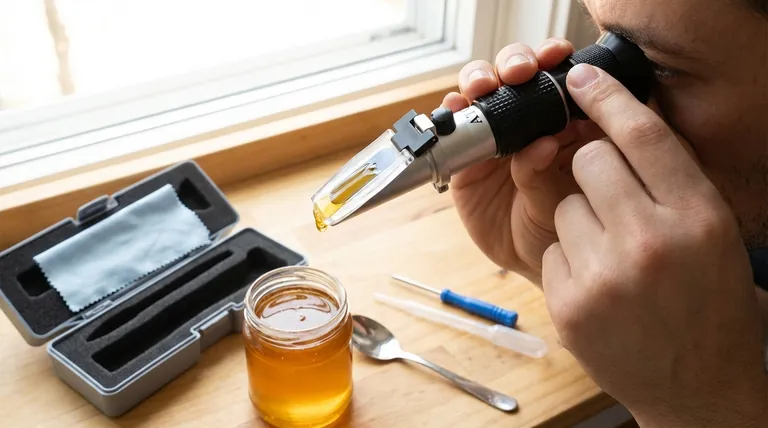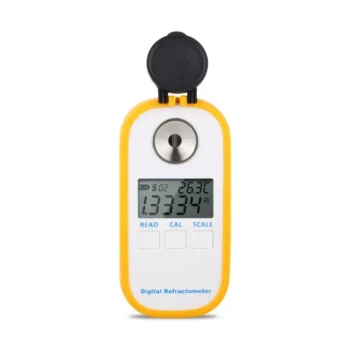To take a reading from a honey refractometer, you look through the eyepiece while pointing the device toward a bright light source. The reading appears at the boundary line where the light and dark areas of the scale meet. If the scale is blurry, simply twist the focal adjuster on the eyepiece until the reading becomes sharp and clear.
A reliable honey refractometer reading is less about the final glance and more about the disciplined process that precedes it. True accuracy comes from proper calibration, sample preparation, and consistent technique, which ensures your honey's quality and stability.

Why a Refractometer Reading is Critical
A honey refractometer measures the moisture content in your honey. This single data point is crucial for determining the quality, stability, and legality of your final product.
Preventing Fermentation
The primary purpose of measuring moisture is to ensure the honey will not ferment. Honey with a high water content provides a breeding ground for osmophilic yeasts, which can spoil the entire batch.
Ensuring Quality and Grade
A reading helps you avoid producing "baker's honey," a lower-grade product that has begun to ferment and is unusable for table-grade sales. Maintaining proper moisture content is a hallmark of high-quality honey.
Meeting Legal Standards
For commercial producers, a refractometer is non-negotiable. Many jurisdictions have legal requirements for honey moisture content, often mandating it be below a specific threshold (e.g., 21.0g per 100g) to be sold.
The Step-by-Step Process for an Accurate Reading
Following a precise methodology ensures your reading is not just a number, but an accurate reflection of your honey's condition.
Step 1: Calibration
Before any use, you must calibrate the refractometer. This sets the baseline for accuracy. Most models are calibrated with a specific calibration liquid or distilled water, but always follow the manufacturer's instructions.
Step 2: Sample Preparation
Ensure the honey and the refractometer are at the same temperature. Temperature differences can skew the reading. If the honey has been stored, give it a gentle stir to ensure the sample is homogenous.
Step 3: Applying the Honey
Place a small amount of honey onto the glass plate or prism. You need just enough to completely cover the surface once the clear panel is closed. Using too much can create a mess, while too little will result in an inaccurate reading.
Step 4: Taking the Measurement
Close the panel over the honey sample and gently wiggle it to remove any trapped air bubbles. Point the refractometer toward a natural light source and look into the eyepiece. Adjust the focus until the scale is sharp. The moisture percentage is the number on the scale where the blue and white sections meet.
Step 5: Post-Reading Cleanup
Immediately after use, clean the refractometer's plate and panel with a damp, lint-free cloth. Proper cleaning prevents residue from affecting future readings and ensures the longevity of your instrument. Store it in a dark, dry place.
Common Pitfalls That Invalidate Your Reading
Even with the right steps, small mistakes can lead to inaccurate data. Being aware of these common errors is essential for reliable measurements.
Ignoring Calibration
Skipping calibration is the most common mistake. An uncalibrated tool provides a number, but you have no way of knowing if that number is correct. Always calibrate before a testing session.
Overlooking Temperature
If your honey is cold from storage and your refractometer is at room temperature, the reading will be unreliable. Allow both to equalize for at least 30 minutes before testing.
Relying on a Single Sample
Moisture content can vary within a single frame or storage container. For the most reliable results, take multiple readings from different sections and calculate an average. This gives a much more accurate picture of the entire batch.
Making the Right Choice for Your Goal
Your approach to using a refractometer should align with your specific objective.
- If your primary focus is preventing spoilage: Pay close attention to keeping moisture content consistently below the 18.6% threshold, the point where fermentation becomes a significant risk.
- If your primary focus is commercial sales: Make meticulous calibration and taking multiple, averaged readings a standard part of your process for defensible quality control.
- If your primary focus is long-term tool maintenance: Make immediate and thorough cleaning after every single use a non-negotiable habit.
Ultimately, mastering the refractometer transforms it from a simple measuring device into a powerful tool for guaranteeing the quality of your harvest.
Summary Table:
| Step | Key Action | Purpose |
|---|---|---|
| 1. Calibration | Set baseline with calibration fluid/water | Ensures instrument accuracy |
| 2. Sample Prep | Equalize honey and refractometer temperature | Prevents skewed readings |
| 3. Application | Cover the prism surface with honey | Provides a sufficient sample for measurement |
| 4. Measurement | Read scale at blue/white boundary line | Determines the moisture percentage |
| 5. Cleanup | Clean plate with a damp, lint-free cloth | Maintains instrument for future use |
Ensure the quality and profitability of every batch with professional-grade equipment from HONESTBEE.
Accurate moisture measurement is the foundation of high-quality honey production. Whether you are a commercial apiary focused on meeting legal standards or a distributor supplying beekeepers, reliable tools are non-negotiable. HONESTBEE supplies durable, precise honey refractometers and other essential beekeeping supplies through our wholesale-focused operations.
Ready to equip your operation for success? Contact our team today to discuss your needs and discover how our products can help you protect your harvest and your reputation.
Visual Guide

Related Products
- Precision Honey Refractometer Instrument for Quality Assessment
- Digital Honey Refractometer for Precision Measurement of Optimal Honey Quality
- Honey Concentrating Vacuum Heating Thickening Machine Dehumidifier for Honey
- Economy Small Scale Honey Dryer Dehumidifier Thickening Machine
- Professional Thermostatic Conical Honey Melter
People Also Ask
- What are the benefits of using a Pocket Digital Honey Refractometer? Achieve Precision & Speed in Honey Quality Control
- What is a honey refractometer? The Essential Tool for Perfect Honey Quality
- Why is a honey refractometer considered essential for commercial beekeepers? Ensure Honey Quality and Profitability
- What is a honey refractometer and what is its purpose? Ensure Honey Quality and Prevent Spoilage
- What are the features of the Standard Refractometer for honey moisture content? Essential Tools for Quality Control



















